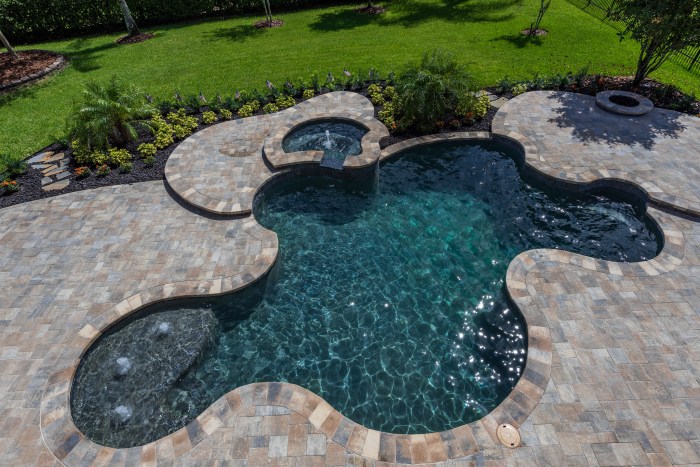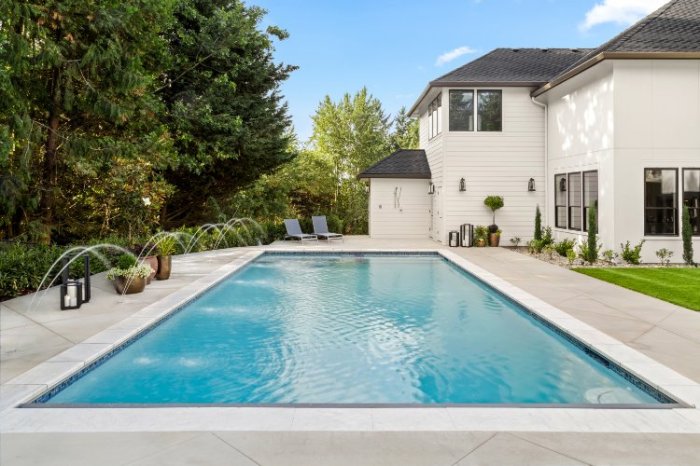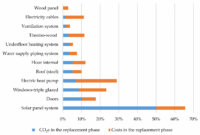How to choose the right size and shape for my backyard pool? It’s a question that sparks dreams of summer days and relaxing evenings. But before you dive headfirst into pool ownership, careful planning is key. This guide walks you through the process, from assessing your available space and considering different shapes to understanding the costs involved and navigating local regulations.
Let’s transform your backyard into the oasis you’ve always envisioned.
Choosing the perfect pool involves more than just picking a pretty picture. Factors like your family’s size, how you plan to use the pool (swimming laps versus lounging), and the overall style of your yard all play a significant role. We’ll explore various pool shapes – from classic rectangles to free-flowing kidney designs – and help you determine the ideal size that balances your desires with your budget and available space.
Get ready to make a splash!
Assessing Your Backyard Space
Before you even start dreaming about diving into your new pool, you need a solid understanding of your backyard’s dimensions and layout. Accurate measurements are crucial for choosing a pool that fits comfortably and leaves enough space for other activities and landscaping. Getting this right upfront saves you potential headaches and costly alterations down the line.
Accurately measuring your backyard involves more than just a quick pace around the perimeter. Start by creating a detailed sketch of your yard, noting all features like trees, sheds, patios, and existing flowerbeds. Use a measuring tape (at least 50 feet long for larger yards) and measure the length and width of your yard at several points, particularly if the shape is irregular.
For curves or oddly shaped areas, break them down into smaller, more manageable sections that can be approximated as rectangles or triangles. Remember to measure from clearly defined points, such as corners of your house or property lines, to maintain consistency.
Measuring Irregular Shapes and Obstacles
Dealing with irregular shapes requires a systematic approach. Divide your backyard into smaller, more regular shapes (squares, rectangles, triangles). Measure each section individually and calculate the area of each shape using standard geometric formulas (e.g., Area of rectangle = length x width; Area of triangle = 0.5 x base x height). Sum the areas of all sections to get the total usable area.
Obstacles like trees or large rocks need to be carefully measured and factored into your calculations. This will help you determine the maximum size pool that can comfortably fit without encroaching on valuable space or compromising safety. Consider a buffer zone around the pool for easy access and to avoid any damage to surrounding structures. For example, if you have a large oak tree near the desired pool location, you might need to reduce your pool size or shift the placement to maintain a safe distance.
Backyard Size and Maximum Pool Dimensions, How to choose the right size and shape for my backyard pool
The following table provides a general guideline for maximum pool dimensions based on backyard size. Remember, these are estimates and may vary depending on the pool shape, desired features, and surrounding landscaping. Always consult with a pool professional for personalized recommendations.
| Backyard Size (approximate) | Shape Options | Maximum Pool Length (ft) | Maximum Pool Width (ft) |
|---|---|---|---|
| Small (under 500 sq ft) | Rectangular, small kidney | 15 | 10 |
| Medium (500-1000 sq ft) | Rectangular, kidney, freeform (small) | 20 | 15 |
| Large (1000-1500 sq ft) | Rectangular, kidney, freeform (medium), L-shape | 25 | 20 |
| Extra Large (over 1500 sq ft) | All shapes, including large freeform, infinity edge | 30+ | 25+ |
Access Points and Future Landscaping
Easy access to your pool is vital for maintenance and safety. Consider the location of your house, gate, and any existing pathways. Ensure there is ample space for a comfortable walkway around the pool. Also, anticipate future landscaping plans. Will you add a patio, deck, or garden?
Leave enough space for these additions without compromising the pool’s aesthetic appeal or functionality. For instance, if you plan to build a large deck around the pool, you’ll need to adjust the pool’s dimensions accordingly to ensure there’s enough space for both. Failing to consider future plans could lead to limited space and costly modifications down the road.
Choosing the Right Pool Shape
Selecting the perfect pool shape is a crucial step in designing your backyard oasis. The shape you choose will significantly impact the overall aesthetic, functionality, and even the cost of your pool. Consider your available space, desired swimming experience, and personal style when making this decision. This section will explore the pros and cons of popular pool shapes to help guide your choice.
Rectangular Pool Shapes
Rectangular pools are classic and timeless. Their straightforward design offers several advantages. They are efficient for lap swimming, making them ideal for serious swimmers. The clean lines of a rectangular pool also tend to complement modern or minimalist landscaping styles. However, rectangular pools can sometimes feel less inviting or less visually interesting than other shapes, particularly in smaller backyards.
They also generally require more space than other options, potentially limiting their suitability for smaller lots.
Freeform Pool Shapes
Freeform pools are known for their organic and natural appearance. Their irregular shapes offer a sense of freedom and fluidity, blending seamlessly with the surrounding landscape. The variety of shapes and sizes possible with freeform designs allows for considerable customization, enabling you to create a unique and personalized pool. However, freeform pools are typically more expensive to construct and maintain than rectangular pools due to their complex designs.
The irregular shape can also make it more challenging to clean and maintain a consistent water level.
Kidney Pool Shapes
Kidney-shaped pools offer a nice balance between the formality of a rectangular pool and the natural flow of a freeform pool. Their curved design creates a softer, more inviting feel than a rectangular shape. Kidney pools are often a good compromise for those who want a visually appealing pool without the added complexity and cost of a fully freeform design.
However, the curved shape can limit the available swimming space compared to a rectangular pool of the same overall area.
Circular Pool Shapes
Circular pools are visually striking and offer a sense of symmetry and elegance. Their compact design can be ideal for smaller backyards where space is limited. The central design can create a focal point for the backyard and lend itself to a variety of landscaping styles. However, circular pools often offer limited swimming space, particularly for lap swimming.
The curved sides can also make cleaning slightly more challenging than with a rectangular pool.
Benefits of Different Pool Shapes
The choice of pool shape significantly impacts the usability and aesthetics of your pool.
- Rectangular Pools: Excellent for lap swimming; easy to clean and maintain; suits modern or minimalist landscapes.
- Freeform Pools: Offers a natural, visually appealing design; highly customizable; blends well with varied landscaping styles.
- Kidney Pools: Combines the elegance of curves with practicality; good compromise between formality and natural design; suits a variety of landscapes.
- Circular Pools: Space-saving design; visually striking; creates a focal point in the backyard.
Pool Shapes and Landscaping
The right pool shape can enhance your backyard’s overall design.A rectangular pool might perfectly complement a modern home with clean lines and structured landscaping. Imagine a sleek, geometric pool with precisely planted hedges and minimalist patio furniture. In contrast, a freeform pool could be nestled amongst lush greenery and natural rock formations, creating a tranquil and inviting space.
A kidney-shaped pool could gracefully curve alongside a winding patio or integrate seamlessly into a landscape featuring gentle slopes and flowing lines. A circular pool could act as a stunning centerpiece in a symmetrical garden, surrounded by meticulously arranged flowerbeds and carefully chosen plants.
Determining the Ideal Pool Size: How To Choose The Right Size And Shape For My Backyard Pool
Choosing the right pool size is crucial for maximizing enjoyment and minimizing regrets. It’s a balance between your family’s needs, your budget, and the practical limitations of your backyard. Consider your lifestyle, the number of people who will regularly use the pool, and how you envision using it.Pool size is directly related to family size and intended use.
A small family who primarily uses their pool for relaxation might be perfectly happy with a smaller, more manageable pool. Conversely, a large family that enjoys swimming laps and entertaining guests might need a significantly larger pool. Consider whether you primarily want a pool for swimming exercise, leisurely floating, or hosting pool parties. A long, narrow pool is ideal for lap swimming, while a larger, free-form pool is better suited for socializing and relaxing.
Pool Volume Calculation
Calculating the appropriate pool volume involves determining the desired surface area and depth. This calculation is essential for accurate estimations of water usage, chemical treatment, and construction costs. Start by measuring the intended area of your pool, or using the dimensions provided by your pool designer. Then, determine your preferred average depth. The formula for calculating pool volume is:
Volume (in cubic feet) = Length (ft) x Width (ft) x Average Depth (ft)
For example, a rectangular pool measuring 15 feet long, 10 feet wide, and 5 feet deep would have a volume of 750 cubic feet. Remember to convert cubic feet to gallons (approximately 7.48 gallons per cubic foot) to understand the total water capacity. This 750 cubic foot pool would hold approximately 5610 gallons of water. This calculation will influence your water bill and the amount of pool chemicals needed for proper maintenance.
Considerations Beyond Pool Dimensions
Beyond the pool’s dimensions, you must account for the surrounding space. Adequate deck space is crucial for comfortable lounging, sunbathing, and entertaining. Consider leaving enough space for furniture, pathways, and landscaping features. Overcrowding the area around the pool can detract from its aesthetic appeal and make maintenance more difficult. Think about the landscaping surrounding the pool; trees and shrubs should be positioned to minimize leaf debris in the water.
Easy access for cleaning equipment and maintenance is also vital. A larger pool might require more time and effort for cleaning, so this should factor into your decision. A smaller, more manageable pool could be a better choice if you value low-maintenance convenience.
Considering Your Budget and Materials
Building a backyard pool is a significant investment, and understanding the costs associated with different materials and pool sizes is crucial for realistic budgeting. The total cost will vary greatly depending on several factors, including the chosen materials, the pool’s size and shape, the complexity of the installation, and your location. Let’s explore these factors in more detail.
The initial cost of the pool itself is only one part of the equation. Ongoing maintenance, including cleaning, chemical treatments, and potential repairs, will add to your long-term expenses. Therefore, careful planning and a comprehensive budget are essential to avoid unexpected financial burdens down the line.
Pool Material Cost Comparison
The material you choose for your pool significantly impacts the overall cost. Concrete, fiberglass, and vinyl-liner pools each offer different price points and longevity.
| Pool Material | Typical Cost Range (USD) | Pros | Cons |
|---|---|---|---|
| Concrete | $40,000 – $100,000+ | Highly customizable, durable, long lifespan. | Most expensive upfront cost, longer construction time. |
| Fiberglass | $30,000 – $60,000 | Relatively quick installation, lower upfront cost than concrete, durable. | Less design flexibility compared to concrete. |
| Vinyl-Liner | $20,000 – $40,000 | Most affordable upfront cost, quick installation. | Shorter lifespan than concrete or fiberglass, liner replacement needed eventually. |
Note: These cost ranges are estimates and can vary widely based on location, size, features, and contractor. Always obtain multiple quotes from reputable contractors.
Pool Size and Shape’s Impact on Cost
The size and shape of your pool directly influence both the initial construction cost and the ongoing maintenance expenses. Larger pools naturally require more materials, leading to higher upfront costs. Complex shapes, such as free-form designs, also increase labor costs and the amount of materials needed, driving up the overall price. Similarly, larger pools require more water, chemicals, and cleaning, increasing maintenance expenses over time.
For example, a small, simple rectangular vinyl liner pool might cost significantly less than a large, elaborate free-form concrete pool with intricate features like waterfalls or spas. A 15′ x 30′ rectangular pool will generally be cheaper to build than a similarly sized kidney-shaped pool due to simpler excavation and construction.
Factors Influencing Total Pool Cost
Beyond material and dimensions, several other factors contribute to the final cost of your backyard pool project.
- Site preparation: Leveling the land, excavating, and grading the area for the pool can add significant costs, especially on uneven or sloped terrain.
- Permits and inspections: Obtaining the necessary permits and undergoing inspections adds to the overall expense.
- Additional features: Features like waterfalls, spas, diving boards, lighting, and heating systems increase the project cost substantially.
- Landscaping: Surrounding the pool with decking, paving, or landscaping enhances the aesthetic appeal but adds to the total budget.
- Contractor fees: Contractor fees vary widely based on experience, location, and demand. Always get multiple quotes and compare before making a decision.
- Location: Construction costs, material prices, and labor rates vary by region. Pools in areas with high labor costs will generally be more expensive.
Visualizing Your Pool Design
Creating a detailed visualization of your pool is crucial for ensuring the final product aligns with your vision and your backyard’s capabilities. This involves more than just a mental picture; a concrete plan, whether a hand-drawn sketch or a digitally created diagram, will guide your contractor and help you avoid costly mistakes down the line.A well-executed visualization considers several key aspects: accurate measurements, realistic placement within your yard, and the integration of safety and aesthetic elements.
This allows you to anticipate potential challenges and make informed decisions before construction begins.
Creating a Detailed Pool Design Sketch
Begin by accurately measuring your backyard. Note the dimensions of your house, existing structures like sheds or patios, trees, and any other significant features. Use graph paper or drafting software to create a scaled drawing of your backyard. Then, carefully sketch your desired pool shape and size, paying close attention to the dimensions you’ve determined in the previous steps.
Indicate the placement of the pool relative to existing structures, ensuring sufficient space for walkways, landscaping, and equipment. Include details like the location of steps, ladders, and any other features you plan to incorporate. For example, if you’re considering a kidney-shaped pool, clearly define its curves and dimensions, and show how it will fit within your available space.
If you are planning a rectangular pool, be sure to indicate its precise length and width. Consider adding labels indicating north, south, east and west to orient yourself and the contractor.
Incorporating Safety Features into the Pool Design
Safety should be a paramount consideration in your pool design. Your sketch should clearly illustrate the planned safety features. This includes fencing that completely surrounds the pool area, preferably with a self-closing and self-latching gate. The height of the fence should meet local building codes, usually at least 4 feet. Additionally, depict non-slip surfaces around the pool deck.
These could be textured concrete, specialized pool decking materials, or even strategically placed mats. Show the location of any safety equipment, such as life rings or a rescue pole, and consider including a shallow area for young children to play safely. For example, a diagram might show a 3-foot high fence with a self-closing gate located 10 feet from the pool’s edge, along with a clearly marked area for non-slip pavers.
Integrating the Pool Design with Landscaping
Effective landscaping can dramatically enhance your pool area’s aesthetic appeal and functionality. Your sketch should integrate the pool with the surrounding landscape. Consider adding elements such as strategically placed trees and shrubs to provide shade and privacy. Show the location of pathways and walkways, ensuring they are wide enough for comfortable movement. Incorporate lighting to highlight the pool and surrounding features at night, using both underwater lights and landscape lighting.
You might show pathways lined with low-voltage landscape lighting, and underwater lights that create a shimmering effect in the pool water. Additionally, you could illustrate the inclusion of water features such as a waterfall or fountain, integrating them seamlessly into the overall design. For instance, a diagram could show a cascading waterfall integrated into a rock feature at one end of the pool, with strategically placed spotlights highlighting the waterfall and pool at night.
Local Regulations and Permits

Source: poolsbybradley.com
Building your dream backyard pool involves more than just choosing the perfect size and shape. Before you even break ground, it’s crucial to understand and comply with local regulations and obtain the necessary permits. Ignoring these steps can lead to costly delays, fines, and even the forced demolition of your pool.Local building codes and regulations regarding pool construction vary significantly depending on your location.
These regulations are designed to ensure public safety and prevent environmental damage. Key aspects often covered include pool fencing requirements (height, type of material, gate self-closing and self-latching mechanisms), minimum distances from property lines, structural requirements for the pool itself (including depth and materials), and water quality standards. Some areas may also have specific regulations related to landscaping around the pool or the type of drainage system required.
It’s important to research these specific requirements for your area.
Understanding Local Building Codes
Local building codes are legal requirements set by your city, county, or state government. These codes specify minimum standards for construction, ensuring the safety and structural integrity of buildings and other structures, including pools. To find your local building codes, you can usually consult your city or county’s website, visit the building department in person, or contact a local building inspector.
These codes often contain detailed specifications on pool construction, including materials, structural components, and safety features. For example, some codes might specify the minimum size of a pool’s coping (the edge surrounding the pool) to prevent falls, or the type of filtration system required to maintain water quality. Failure to adhere to these specifications can result in the rejection of your permit application or even legal action.
Obtaining Necessary Permits and Approvals
The process of obtaining the necessary permits typically involves submitting a detailed application to your local building department. This application will usually require detailed plans of your pool, including dimensions, materials, and any special features. You may also need to provide proof of property ownership, surveys showing the pool’s location relative to property lines, and possibly engineering reports confirming the structural integrity of the design.
The building department will review your application to ensure it complies with all relevant codes and regulations. Once approved, you will receive a permit allowing you to begin construction. Remember, starting construction without the proper permits can result in significant penalties. The specific requirements and processing times for permits vary significantly by location, so it’s best to contact your local building department early in the planning process.
Importance of Consulting with Local Authorities and Professionals
Consulting with local authorities and professionals is essential for a smooth and compliant pool installation. The building department can provide you with specific information about local codes and the permit application process. Working with a qualified pool contractor is also highly recommended. Experienced contractors are familiar with local regulations and can help you navigate the permit process and ensure your pool meets all safety and code requirements.
They can also advise on suitable pool designs and materials based on your site conditions and local regulations. Early consultation minimizes the risk of encountering unforeseen problems during the construction process, saving you time, money, and potential headaches. Remember, proactive engagement with local authorities and professionals is key to a successful and legal pool installation.
End of Discussion

Source: coastalluxurypv.com
Building a backyard pool is a significant investment, both financially and emotionally. By carefully considering your space, desired pool shape, budget, and local regulations, you can create a personalized aquatic haven that perfectly complements your lifestyle and landscape. Remember, the process is as much about thoughtful planning as it is about enjoying the final result. So, take your time, visualize your dream pool, and get ready to enjoy countless hours of fun in the sun!
FAQ Overview
What’s the average lifespan of different pool types?
Concrete pools generally last the longest (50+ years), followed by fiberglass (25-30 years), and then vinyl-liner pools (9-15 years).
How much does pool maintenance typically cost annually?
Annual maintenance costs vary widely depending on pool size, type, and climate, but expect to spend anywhere from $1000 to $3000 or more per year.
What are some energy-efficient options for pool heating?
Solar pool heaters and heat pumps are more energy-efficient than gas heaters. Consider a pool cover to reduce water evaporation and heat loss.
Do I need a permit to build a pool?
Almost certainly. Check with your local building department for specific requirements in your area.
Can I install a pool myself?
While possible for smaller, above-ground pools, most in-ground pools require professional installation due to complex construction and safety considerations.



